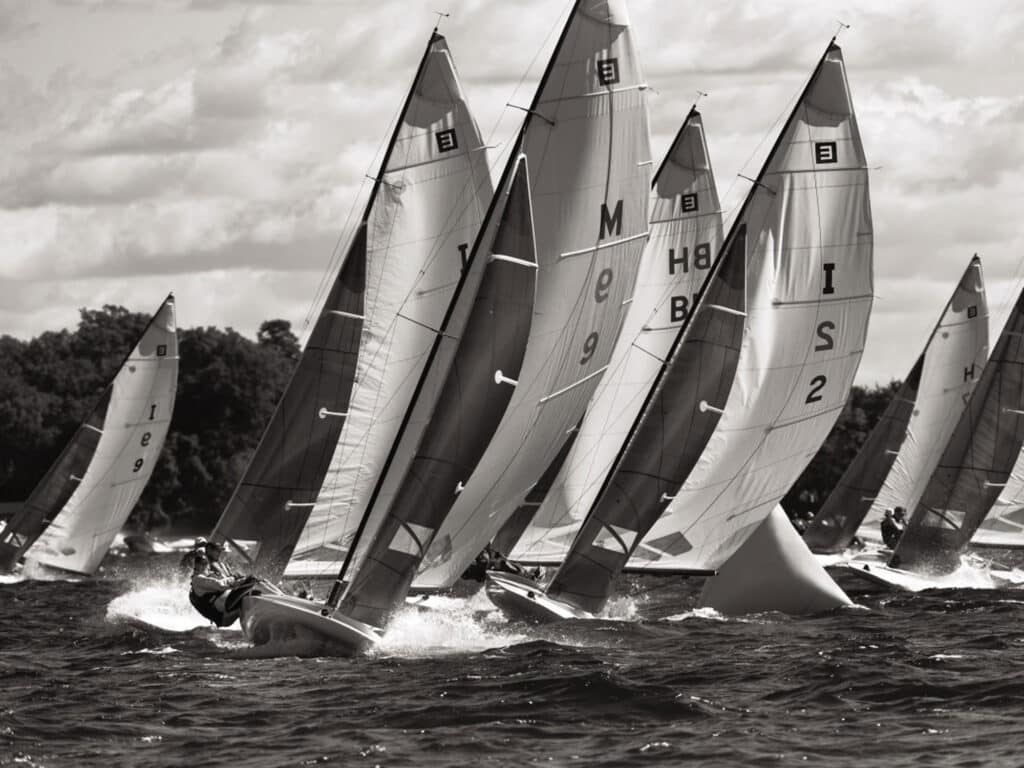
20 seconds after the start, I look over my shoulder and can tell we’re going to have a rough one. We’ve started near the pin in the first race of the 2022 E Scow National Championship on my home Lake Minnetonka. With a half-mile-long starting line set to accommodate 69 boats, the righty I’m now seeing sends a parade of sails marching up inside us, and our only option is to keep going left.
With patience, situations like this can often work in one’s favor. On inland lakes, it’s common for both sides to be advantaged at some point during a beat. “Win your side” is the adage. I glance up toward Brackett’s Point on the lake’s western shoreline, where I’ve seen countless lefties roll through from this direction in the past. But when the next puff hits, we lift higher and higher.
Yup, we’re going to have a rough one.
I’ve sailed on Lake Minnetonka my entire life, but I’ve never seen the wind do this before. A few hours before racing, a cold front rolled through from the bottom of Canada, littering the upper Midwest with storm cells. The result: a blustery breeze between 8 and 18 knots with up to 40-degree windshifts—an absolute nightmare for the race committee, who spent most of the day hoisting postponement and general recall flags before finally getting a race off at 3 p.m. Now that we’re underway, I find myself somewhere in the back of the midfleet, praying for a shift that will never come.
The E Scow midfleet is a scary place. First beats in this class are absolute bloodbaths, and since the boats are 28 feet long with 6-foot beams, the lanes, like the hulls, are long and narrow. With sails blanketing your vision every way you look, it’s easy to get disoriented. When packs of boats meet, skippers make split-second decisions that can either salvage a race or send them drifting into the netherworld. As we make our way up the beat, I’m finding that most of the rules of midfleet sailing do not apply to today’s racing.
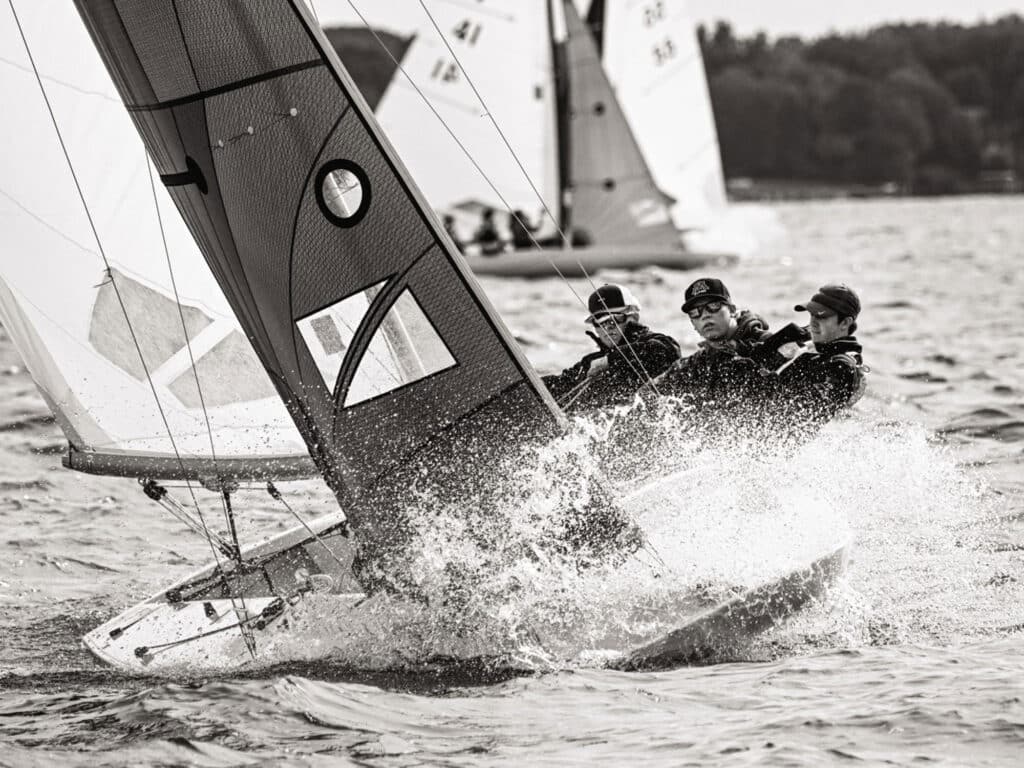
Across the lake, I see boats knocking into each other on opposite tacks. Other boats find mystery puffs in the middle of the course that somehow point them up to the mark, while teams on the edges get absolutely thrashed. As a skipper, I try not to let my mind wander, but as we claw our way through this ball-buster of a beat, I can’t help having one of those “How did I get here?” moments.
My journey into this situation started at age 8 when my parents signed me up for lessons at the Lake Minnetonka Sailing School, which shares a property with the Minnetonka YC on a small island on the eastern shore of the lake. This island setup is a relic of the 19th century, when most sailing families lived on the lake and could dock their boats at their houses. Needless to say, socioeconomics has changed a lot since 1882 when MYC was founded, but the geography of an island yacht club remains a novelty for out-of-towners and a logistical nightmare for local regatta committees trying to run a big event like the E Scow Nationals.
None of this was obvious to me when I first started sailing. In fact, riding a pontoon boat to the island every day in summer felt adventurous. After a few years of Opti sailing, my coach, Gordy Bowers, gave me my first ride on an E Scow as his fourth crew. Bowers is known nationally for coaching the 1988 US Olympic Team. On Lake Minnetonka, he was a feared competitor in his prime and has since become a scow guru in old age. He won back-to-back E Scow Nationals in the ’70s, along with a dozen other national and ILYA championships in A, C and MC scows throughout the years.
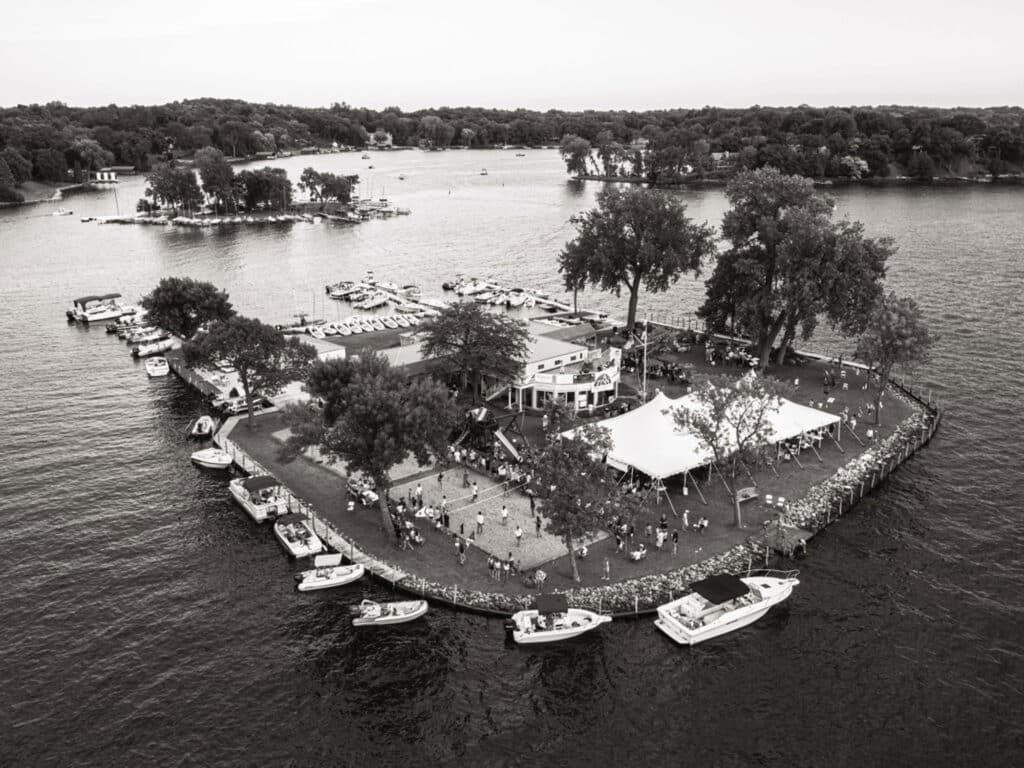
Bowers grew up at MYC and came from one of the big, almost aristocratic sailing families on the lake, many whose names are inscribed on every scow sailing trophy in the country. But he didn’t care what my last name was. He picked me because I could hike hard, and when we shoved off for that first day of E boating, he taught me what to do as we went along. He was always patient and articulate, which made him the perfect teacher for a first‑time E boater.
The wind was blowing hard out of the east, and since E boats still had symmetric spinnakers, I remember how precise he was with adjustments to the spinnaker pole tip—an inch or two of guy here, a micrometer of topping lift there. I even remember fouling someone and having to do a penalty turn in the middle of a club race, which is something our current MYC E fleet seems to have forgotten how to do in recent years.
For Many in the E fleet, it doesn’t matter how many championships you’ve won in other classes. This is the proving ground.
The next time I raced an E Scow was with Bill Allen, who won an Olympic gold medal with Buddy Melges and Bill Bentsen in the Soling in 1972. Allen is regarded as one of the finest E Scow helmsmen of all time, having won six national championships, seven ILYA championships, and no fewer than 10 E Blue Chips. He took me and his son, Brian, out for a Wednesday club race, and I remember how excited I was to sail with a gold medalist.
I figured Allen would be a lot like Bowers, taking the time to teach me the finer points of crew work, realizing that I’m a beginner and letting me learn at my own pace. He had me doing bow while Brian did middle. By then I was crewing regularly on an X-boat, which uses a whisker pole downwind. When we rounded the weather mark in first, our lead quickly disappeared when I attempted to jibe the pole the way you would in an X-boat, leaving the end clipped in and trying to push the clew of the kite to the opposite side of the boat. “What the hell are you doing?” Allen screamed at me from the helm. “Get that goddamn spinnaker flying you little son of a bitch!” I must have been 13 at the time.
Over the years, I’ve sailed against a lot of great sailors in a lot of great venues, but there’s nothing like coming back to “Golden Pond,” what locals call Lake Minnetonka, and duking it out in one of the best one-design fleets in the country. When I talk to people on the coasts about scows, they often view them as exotic and strange—missile-shaped boats with fin-shaped rudders, bilge boards in place of keels, planing hulls that skim atop the water instead of pushing through it. But what seems exotic to some is a way of life in the northland, where we play hockey in the winter and race scows in the summer, the intensity of one sport never letting up in the other. Up here, a weekly championship race is more of a communal bloodletting ritual than a friendly competition among neighbors. When you sail against the same people your entire life, you tend to develop long memories. Although Minnesotans are known to hide their emotions behind modest Midwest demeanors, when it comes to racing E Scows on Lake Minnetonka, it gets personal.
For many in the E fleet, it doesn’t matter how many championships you’ve won in other classes. This is the proving ground. These are the boats where legends are made, and if you haven’t dropped the gloves in this fleet, you simply aren’t worthy of respect. It’s a part of the culture I’m not always fond of. The intensity of competition can be difficult for people trying to break in, which is a shame because there are so many great sailors in the area who don’t race scows. Yet the quality of racing cannot be denied, and the truth is that on Lake Minnetonka, respect isn’t something you ask for. It’s something you earn by winning races.
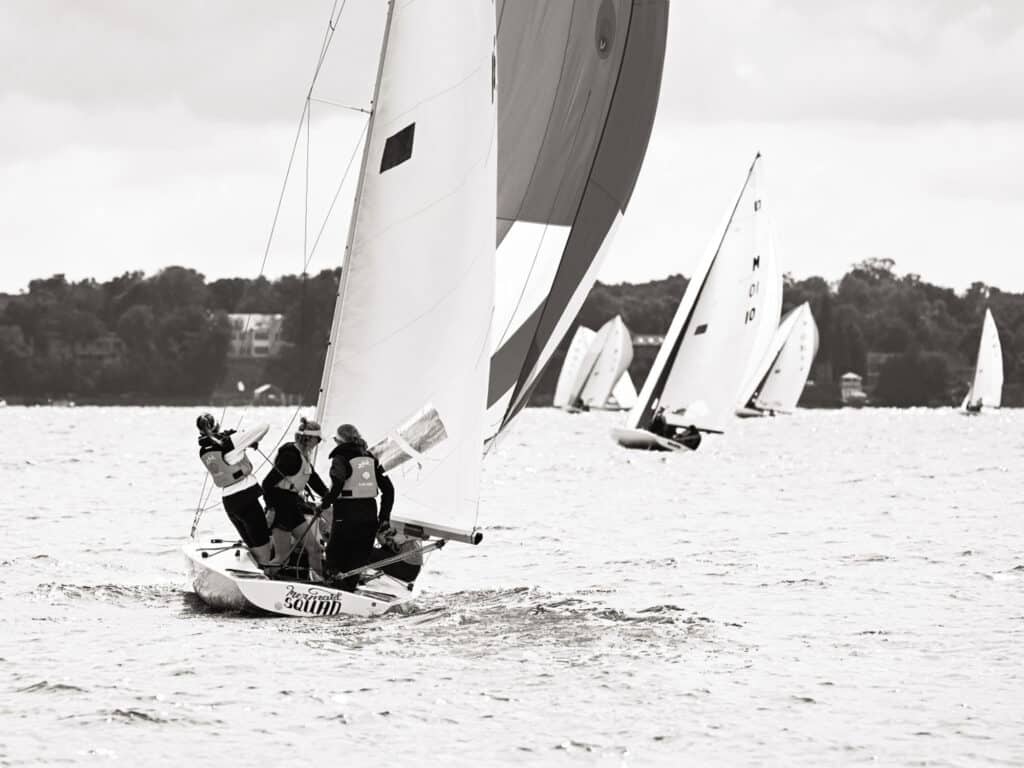
Because paid hands are banned in E Scows, the teams, like the rivalries, remain homegrown. Locally, Sam Rogers has been the guy to beat for some time. Rogers has two national championships under his belt, and as a former pro sailor, he raises the bar of competition exponentially. Known for his fiery temper on the racecourse, everyone on the lake has a “Sam story,” which makes beating him that much sweeter.
Another top gun is Tom Burton, who has been racing E Scows on Lake Minnetonka since the 1970s. Burton has also won two national championships, and his family has been a fixture at MYC since his great-grandfather, Hazen Burton, served as a charter member.
I grew up watching Burton race A and E scows, and we’ve gotten to know each other better since I became a substitute main trimmer for him on the A boat a few years ago. Unfortunately, he tore his Achilles tendon slipping off his powerboat a few weeks before the E Scow Nationals, effectively ending his sailing season in mid-July. When the Burton family called to ask if I’d like to steer their boat for the regatta, I immediately cleared my schedule and booked a flight home to Minnesota.
On Lake Minnetonka, respect isn’t something you ask for. It’s something you earn by winning races.
So, here I find myself buried in the fleet in race one at the Nationals, where boats drift in and out of my periphery like circling sharks. One thing I know about midfleet racing is that you have to take your medicine when it comes, so instead of sending it into the corner, I stay on the lifted tack and try to find clear air when possible. These are the two things I focus on most—staying on the lifted tack and finding clean breeze—and boat by boat, we begin to work our way through the fleet. Being a new member to this squad, I wonder what my teammates think of my disastrous start.
Over the years, Burton has developed this rock-star crew with his son Charlie on jib trim and his good friend Bruce Martinson in the middle. On weekdays, Martinson runs a dentist practice, but when he’s away from work, he’s either racing Lasers, J/22s or E Scows on Lake Minnetonka. He’s also an international sailing judge, and when he’s not racing, he’s somewhere around the world throwing top-level sailors out of the protest room. In fact, throughout the years, Martinson has chucked me from more protests than I would like to admit, and sailing with him now is kind of like racing with a lawyer on board. More importantly, he has a great feel for boatspeed and an even better ability to feed me information without trying to influence my decision-making. He gives me compass headings in a sober, almost lifeless voice, sometimes calling out 20-degree headers as we forgo the lifted tack in a scramble for fresh breeze.
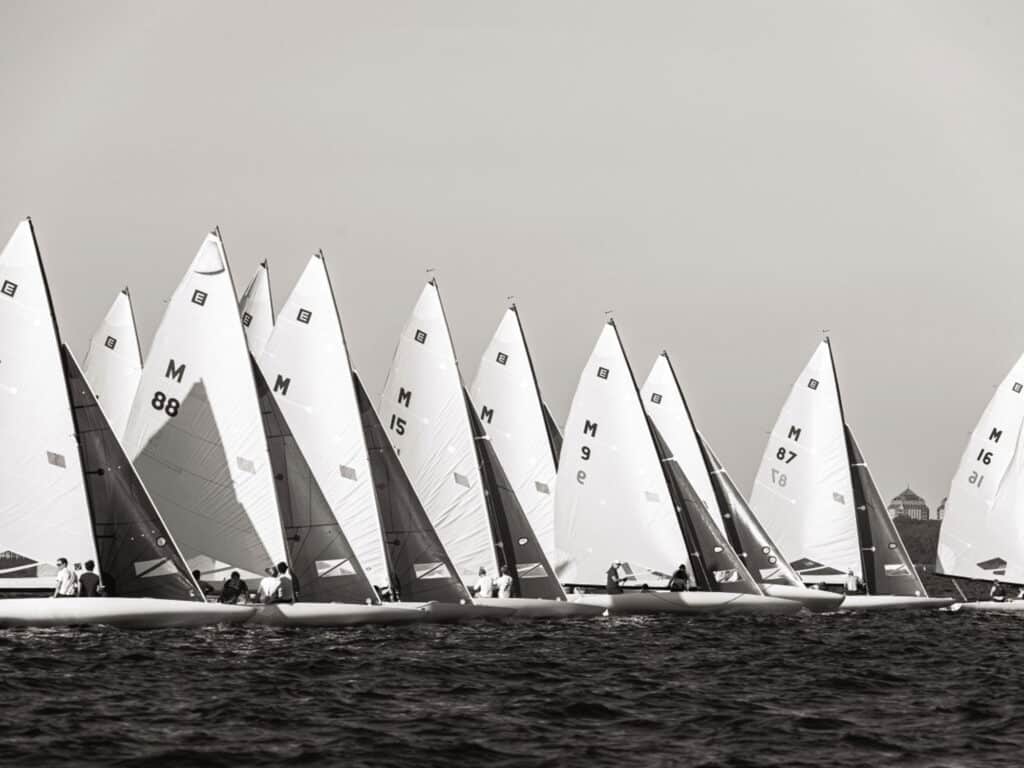
The fourth member of our team is Parker Laing, a junior at Minnetonka High School, who we plucked off the Lake Minnetonka Sailing School bench. This is her first day racing E Scows, and I can’t help remembering my first time with Bowers. Now that I have the tiller in my hands, I hope to emulate his patience and professionalism. As a team, we cut our way through the 69-boat fleet to finish 25th.
This will become the theme of our regatta. Over the following four races, we only have one good first beat, spending most of our time clawing through midfleet traffic. At one point, we tack inside the zone at a weather mark and have to do a penalty spin before hoisting. Another time, we accelerate late at a start and watch the boats on both sides of us shoot into the top five at the top. But little by little, we dig ourselves out and avoid the deep finishes that many of the top teams incur. We finish the regatta with a pair of top-10 results, which lifts us to fifth overall.
A top-five at the E Scow Nationals with this team—in front of a home crowd—means the world to me. But most important is the ability to race with friends, mentors and current students on the waters that I love. Lake Minnetonka will always be my favorite place to race sailboats, and the community we have is world-class. Yes, it can be tribal at times, but the racing is second to none, as are the friendships we’ve all made. Growing up here, I’ve had many mentors to look up to. With a fresh crop of young guns coming out of the sailing school and getting into scows, the future looks equally bright. With the E Scow class celebrating its centennial next year at the Nationals in Madison, Wisconsin, next summer can’t come soon enough.









